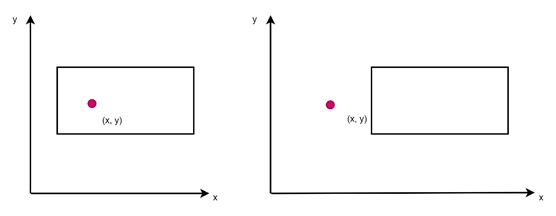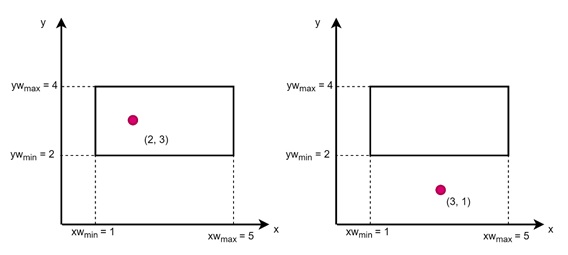
- Computer Graphics - Home
- Computer Graphics Basics
- Computer Graphics Applications
- Graphics APIs and Pipelines
- Computer Graphics Maths
- Sets and Mapping
- Solving Quadratic Equations
- Computer Graphics Trigonometry
- Computer Graphics Vectors
- Linear Interpolation
- Computer Graphics Devices
- Cathode Ray Tube
- Raster Scan Display
- Random Scan Device
- Phosphorescence Color CRT
- Flat Panel Displays
- 3D Viewing Devices
- Images Pixels and Geometry
- Color Models
- Line Generation
- Line Generation Algorithm
- DDA Algorithm
- Bresenham's Line Generation Algorithm
- Mid-point Line Generation Algorithm
- Circle Generation
- Circle Generation Algorithm
- Bresenham's Circle Generation Algorithm
- Mid-point Circle Generation Algorithm
- Ellipse Generation Algorithm
- Polygon Filling
- Polygon Filling Algorithm
- Scan Line Algorithm
- Flood Filling Algorithm
- Boundary Fill Algorithm
- 4 and 8 Connected Polygon
- Inside Outside Test
- 2D Transformation
- 2D Transformation
- Transformation Between Coordinate System
- Affine Transformation
- Raster Methods Transformation
- 2D Viewing
- Viewing Pipeline and Reference Frame
- Window Viewport Coordinate Transformation
- Viewing & Clipping
- Point Clipping Algorithm
- Cohen-Sutherland Line Clipping
- Cyrus-Beck Line Clipping Algorithm
- Polygon Clipping Sutherland–Hodgman Algorithm
- Text Clipping
- Clipping Techniques
- Bitmap Graphics
- 3D Viewing Transformation
- 3D Computer Graphics
- Parallel Projection
- Orthographic Projection
- Oblique Projection
- Perspective Projection
- 3D Transformation
- Rotation with Quaternions
- Modelling and Coordinate Systems
- Back-face Culling
- Lighting in 3D Graphics
- Shadowing in 3D Graphics
- 3D Object Representation
- Represnting Polygons
- Computer Graphics Surfaces
- Visible Surface Detection
- 3D Objects Representation
- Computer Graphics Curves
- Computer Graphics Curves
- Types of Curves
- Bezier Curves and Surfaces
- B-Spline Curves and Surfaces
- Data Structures For Graphics
- Triangle Meshes
- Scene Graphs
- Spatial Data Structure
- Binary Space Partitioning
- Tiling Multidimensional Arrays
- Color Theory
- Colorimetry
- Chromatic Adaptation
- Color Appearance
- Antialiasing
- Ray Tracing
- Ray Tracing Algorithm
- Perspective Ray Tracing
- Computing Viewing Rays
- Ray-Object Intersection
- Shading in Ray Tracing
- Transparency and Refraction
- Constructive Solid Geometry
- Texture Mapping
- Texture Values
- Texture Coordinate Function
- Antialiasing Texture Lookups
- Procedural 3D Textures
- Reflection Models
- Real-World Materials
- Implementing Reflection Models
- Specular Reflection Models
- Smooth-Layered Model
- Rough-Layered Model
- Surface Shading
- Diffuse Shading
- Phong Shading
- Artistic Shading
- Computer Animation
- Computer Animation
- Keyframe Animation
- Morphing Animation
- Motion Path Animation
- Deformation Animation
- Character Animation
- Physics-Based Animation
- Procedural Animation Techniques
- Computer Graphics Fractals
Point Clipping Algorithm in Computer Graphics
In the previous chapter, we presented an overview of several clipping algorithms. From this chapter, we will explain these clipping algorithms in detail for a better understanding of these concepts. In this chapter, we will cover point clipping in detail. This is the most fundamental and easiest algorithm to clip a point inside a viewport.
What is Clipping?
We have covered the concept of Windowing and Viewing in the previous chapter. These are useful when putting something inside a fixed window. And to reduce computation, we ignore all the things outside the window.
Formally, clipping means the procedure used to identify parts of a picture that are either inside or outside a specified region. This region is called the clip window. Clippings are used in these fields and some other fields as well.
- Extracting specific parts of a scene for viewing
- Determining visible surfaces in 3D views
- Handling drawing and painting operations
- Supporting multi-window environments
The clip window can either be a simple polygon or have more complex boundaries like curves, depending on the application.
What is Point Clipping?
Point clipping is a type of clipping algorithm that focuses specifically on determining whether a point lies within the clip window or not. This method checks if a point is within the bounds of the rectangular region defined by the clip window.

Here the point (x, y) is inside the window in the left figure so it is not clipped. But in the right hand side image, the window is shifted to the right and the point in outside the window, so it will be clipped (removed from the window) its calculation is not needed anymore.
How Point Clipping Works?
Assume we have a point P = (x, y) and a rectangular clip window defined by the following boundaries:
- xwmin − The minimum x-coordinate of the clip window
- xwmax − The maximum x-coordinate of the clip window
- ywmin − The minimum y-coordinate of the clip window
- ywmax − The maximum y-coordinate of the clip window
To determine whether the point P lies within the clip window, we check the following inequalities:
- xwmin < x < xwmax
- ywmin < y < ywmax
If the point P satisfies all these conditions, it is saved for display. However, if P does not satisfy any of these inequalities, it is considered outside the clip window and is clipped, meaning it will not be displayed.

Here the (xwmin, ywmin) = (1, 2) and (xwmax, ywmax) = (5, 4), the point coordinate is (2, 3)
For the first case, it satisfies the conditions:
- 1 < 2 < 5
- 2 < 3 < 4
For the second case, the point is at (3, 1) so it does not satisfies the condition for y, and it is clipped.
- 1 < 3 < 5
- 2 < 1 < 4 (invalid condition)
Applications of Point Clipping
While point clipping is not as commonly used as other types of clipping (such as line or polygon clipping), there are specific cases where point clipping is essential. For example −
- In particle systems, where points represent individual particles in scenes like explosions or sea foam, point clipping ensures that only particles within the visible region are displayed.
- In large datasets, where millions of points need to be visualized, point clipping helps in managing and displaying only the relevant data points within the clip window.
Point clipping provides a simple and efficient method to manage such cases, ensuring that only necessary data is shown on the screen.
Conclusion
In this chapter, we covered the basics of clipping and the different types of clipping algorithms. We then focused on point clipping, explaining how it works by checking whether a point lies inside or outside a rectangular clip window. We also discussed the importance of point clipping in specific applications, such as particle systems and large datasets.